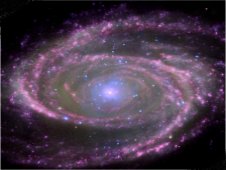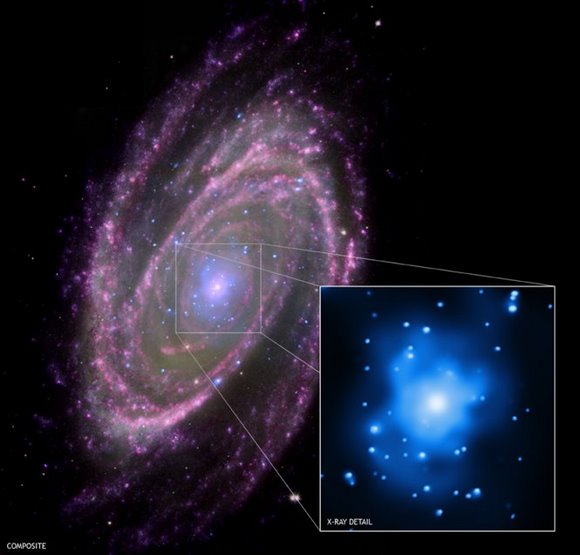Worried about how you’re going to feed your black hole once it grows up and gets big? Have no fear. New data from the Chandra X-ray Observatory indicates that even the biggest black holes may feed just like the smallest ones. Using new observations and a detailed theoretical model, a research team compared the properties of the black hole of the spiral galaxy M81 with those of smaller, stellar mass black holes. The results show that big or little, black holes appear to eat similarly to each other, and produce a similar distribution of X-rays, optical and radio light. This discovery supports the implication of Einstein’s relativity theory that black holes of all sizes have similar properties.
M81 is about 12 million light years from Earth. In the center of M81 is a black hole that is about 70 million times more massive than the Sun, and generates energy and radiation as it pulls gas in the central region of the galaxy inwards at high speed.
In contrast, so-called stellar mass black holes, which have about 10 times more mass than the Sun, have a different source of food. These smaller black holes acquire new material by pulling gas from an orbiting companion star. Because the bigger and smaller black holes are found in different environments with different sources of material to feed from, a question has remained about whether they feed in the same way.

“When we look at the data, it turns out that our model works just as well for the giant black hole in M81 as it does for the smaller guys,” said Michael Nowak, from the Massachusetts Institute of Technology. “Everything around this huge black hole looks just the same except it’s almost 10 million times bigger.”
One of the implications of Einstein’s theory of General Relativity is that black holes are simple objects and only their masses and spins determine their effect on space-time. The latest research indicates that this simplicity manifests itself in spite of complicated environmental effects.
The model that Markoff and her colleagues used to study the black holes includes a faint disk of material spinning around the black hole. This structure would mainly produce X-rays and optical light. A region of hot gas around the black hole would be seen largely in ultraviolet and X-ray light. A large contribution to both the radio and X-ray light comes from jets generated by the black hole. Multi-wavelength data is needed to disentangle these overlapping sources of light.
Among actively feeding black holes the one in M81 is one of the dimmest, presumably because it is “underfed”. It is, however, one of the brightest as seen from Earth because of its relative proximity, allowing high quality observations to be made.
“It seems like the underfed black holes are the simplest in practice, perhaps because we can see closer to the black hole,” said Andrew Young of the University of Bristol in England. “They don’t seem to care too much where they get their food from.”
This work should be useful for predicting the properties of a third, unconfirmed class called intermediate mass black holes, with masses lying between those of stellar and supermassive black holes. Some possible members of this class have been identified, but the evidence is controversial, so specific predictions for the properties of these black holes should be very helpful.
In addition to Chandra, three radio arrays (the Giant Meterwave Radio Telescope, the Very Large Array and the Very Long Baseline Array), two millimeter telescopes (the Plateau de Bure Interferometer and the Submillimeter Array), and Lick Observatory in the optical were used to monitor M81.
The results of this study will appear in an upcoming issue of The Astrophysical Journal.
News Source: NASA’s Chandra Website


My bad, I’m pulling mine now! Sorry Nancy, spent too much time reading about Planet X, Pluto and black holes, I didn’t see your article!
Cheers, Ian 🙂
I thought something was odd! 🙂
What happened to “Supermassive Black Holes are Not Fussy Eaters”, the first article linked in this edition (08.06.19) of Universe Today? When I tried to bring up the article, I got “404 Error – page not found.” Was that article supposed to be this one?
When I was 10 I read about the universe, galaxies and black holes by a German Scientist (Prof. Dr. Hans Haber) and concluded that the spiral movement of all Galaxies is an indicator for a super massive black hole in the center… and if they do not move the way they do, no black hole, no galaxy.
What makes Einstein’s theories so good is their perfect logic. He’s proven right again and again… Let’s wait and see..
Mwah ha ha.
Heh heh.
Guess it just means it’s a really really really really cool story 😉
Hi Yael Drag,
Yes, I was being careless and didn’t check UT for updates and I duplicated what Nancy talks about here, so I removed my article. So not to waste it, I posted it on my website instead.
Goes to show this is some superb research! Enjoy 🙂
Ian
What is really amazing, is the infinite scale of our Universe.
From the infinitely small to the infinitely large.
It is all the same action.
Electromagnetic attraction plus turbulance.
Yes Tony Trenton, that is the only reason why the universe exists. Can we imagine something infinite?
nope:) Looking for answers is good… Speculation is not good. Big Bang is a joke as it constitutes a location in Space from “where it all began”. And then we ask: what was before the BB occurred?
Again, what you wrote Heinz Haber wrote in one of his publications in the 60’s.
Quote
[What is really amazing, is the infinite scale of our Universe.
From the infinitely small to the infinitely large.
It is all the same action.
Electromagnetic attraction plus turbulence.]unquote
I have a question. It seems that every galaxy has a black hole at its core, what than is the purpose of the black hole and what is its relationship with the galaxy?